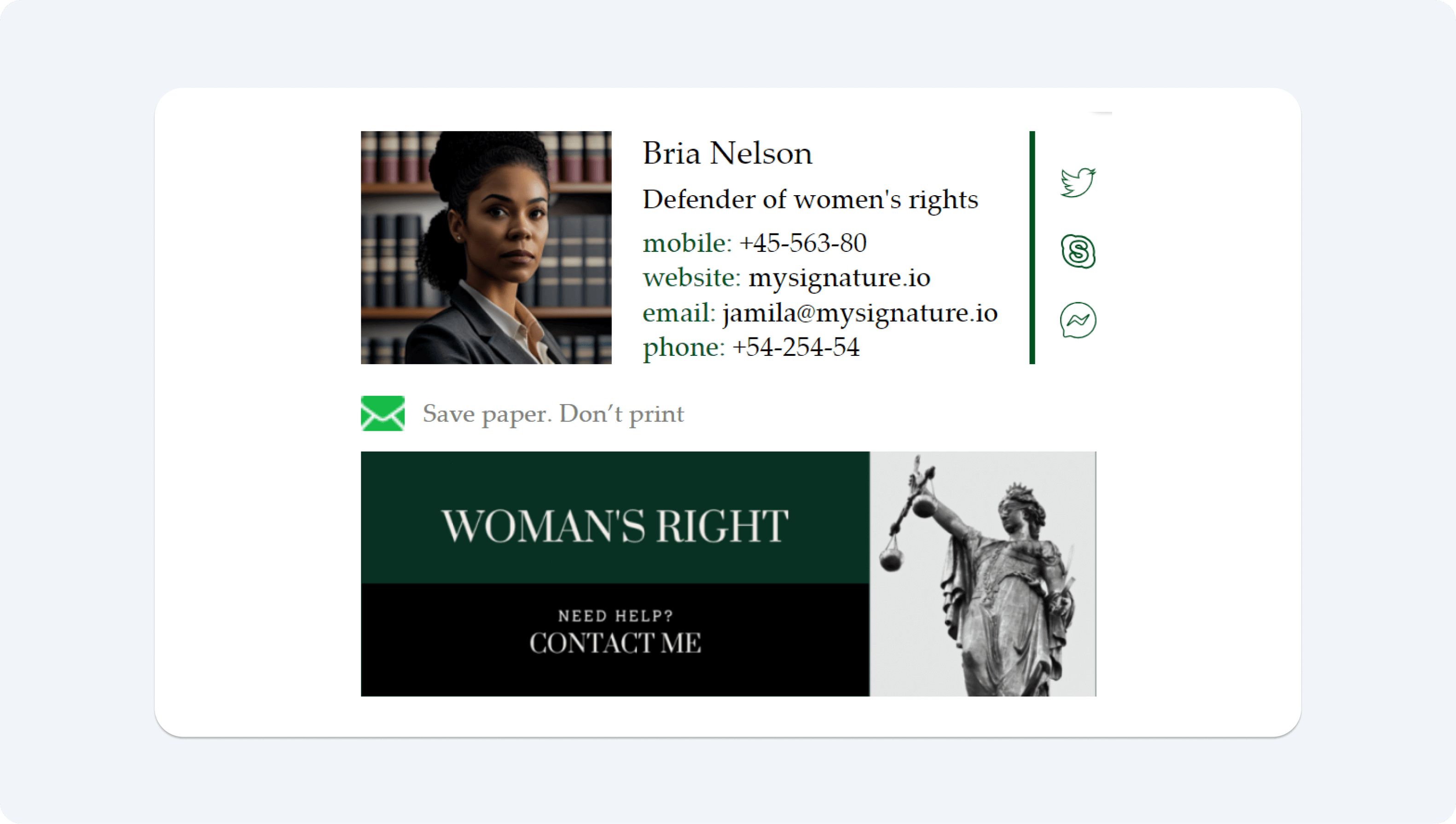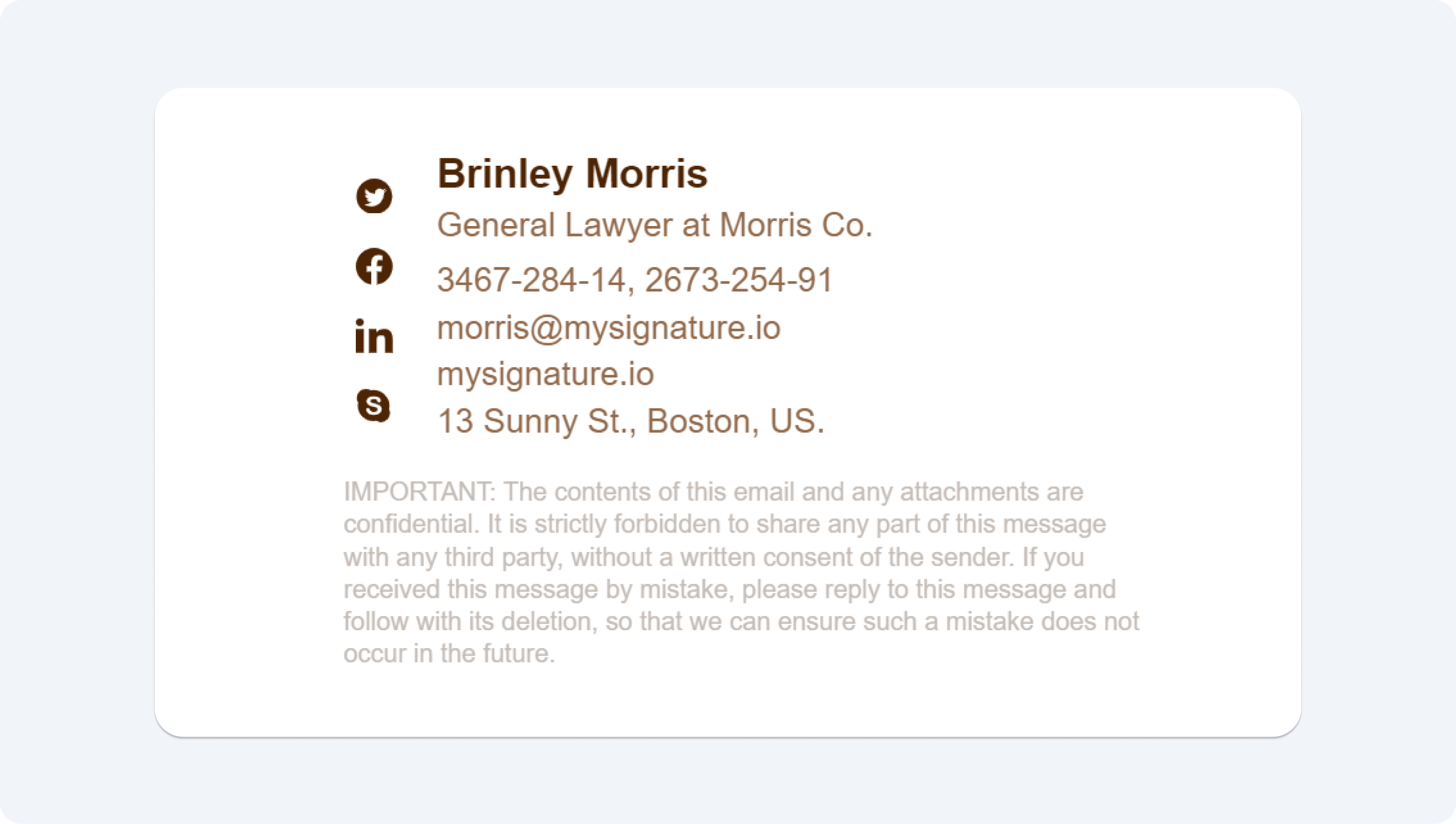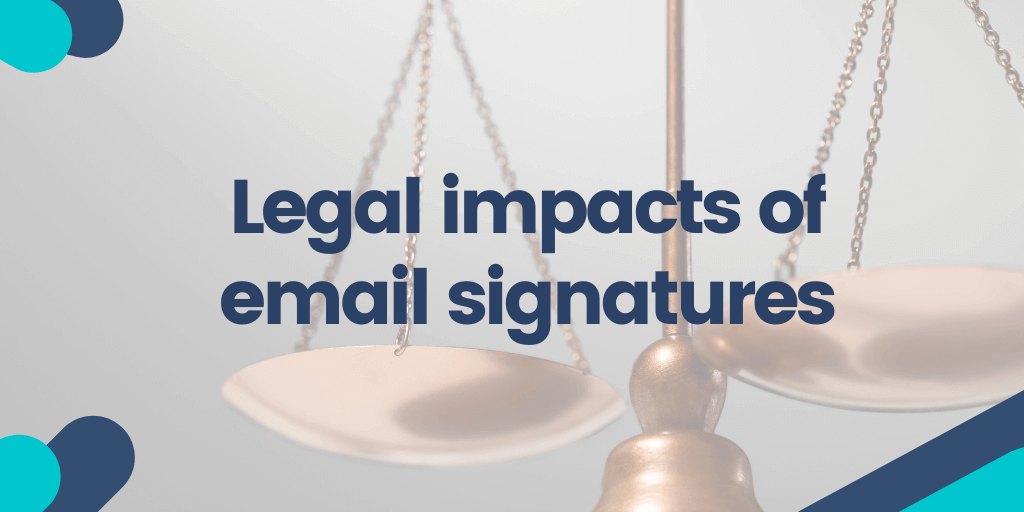Email signatures are one of the basics of digital communication in every business environment. Although they are used every day, companies shouldn’t forget that email signatures have legal implications to be aware of. In view of strict data protection standards such as GDPR, it’s essential to know how to compose compliant email signatures.
This article looks into the legal implications of email signatures, lists the recommended practices and also discusses repercussions for non-compliance.

Ensuring adherence to laws governing the protection of information
Email signatures are becoming increasingly relevant from a legal point of view, mostly related to today's digital landscape and especially due to the enforcement of data protection provisions like the EU's GDPR and beyond. For instance, since the GDPR came into effect in 2018, there have been over 1,000 fines issued across Europe, with total fines exceeding €1.6 billion .
With the growing email marketing trend and emphasis on seeking consent, there is a need to have safer mechanisms and technical measures for protecting personal information and hence bringing transparency to correspondence. Data Security posture management is essential in ensuring that these measures are properly implemented and maintained.
Therefore, organizations need to know how to use these signatures in compliance with data protection laws to avoid a potential data breach or fines. The average cost of a data breach in 2023 was $4.45 million, up from $3.86 million in 2020, underscoring the financial risks associated with non-compliance.
Understanding data protection laws
The GDPR establishes rigorous data protection laws that every organization handling personal information must comply with. These regulations impose stringent requirements on the collection, use, and storage of personal information to protect individual privacy rights. The GDPR mandates obtaining explicit consent from users and creating a legal basis for processing personal data. Compliance with these regulations mitigates the risk of severe penalties.
Overview of GDPR
The GDPR is a broad framework designed by the EU in respect of personal information and the privacy of persons it covers. It details strict data protection compliance that an organization must adhere to, among other things.
It focuses on the need to have clear consent from people before any form of processing is done with their information, stating what legal obligations an organization has to fulfill in protecting an individual's private information.
The basic principles of lawfulness, fairness, transparency, and accountability define the core intention of GDPR in making individuals more in control of their respective data while ensuring that organizations handle data ethically. According to a 2023 study by Cisco, 92% of businesses see a competitive advantage in adopting strong data privacy practices, illustrating the business value of GDPR compliance .

Some of the principal individual rights mapped within the GDPR include access to one's information, the ability to correct or delete it, opting out from processing altogether, and transmissibility of data from one system to another. This transmissibility right can be facilitated by solutions that streamline data migration, such as migrating data from MySQL to Snowflake.
The promotion of these principles and rights creates a relationship that is built on trust between people and companies under the GDPR. Managing GDPR compliance across all organizational touchpoints requires sophisticated oversight, which is why many companies are implementing legal AI agents to continuously monitor and update their compliance protocols, including email signature requirements. This leads to a much safer cyber space.
Legal requirements for email signatures
Email signatures are required to meet legal demands that, among others, ensure that institutions provide brief, clear information about data protection in consideration of people's rights over their private information.
The requirements in this regard include sender identification, contact detail provision, and also compliance statements.
Identifying the sender
One very relevant factor to data protection compliance in the email signature is the sender's identity. This lets recipients know and understand with whom they are dealing.
Therefore, email signatures should contain the name, title, organization, and other relevant contact information in order to promote confidence and fulfill privacy rights. Today, with the rise in data vulnerabilities and their associated privacy concerns, sender's identification is more important than ever.
Besides adhering to regulations such as GDPR, clear sender identification also mitigates the risks of phishing attacks and enables users to better safeguard their information.

Therefore, one can say that an organization dedicated to the clear identification of senders instills a culture of trust and accountability, which works not only to safeguard its legal obligations but also the expectations of protection from the users regarding their data.
Providing contact and compliance information
Contact details should be included in the email signature as they ensure that the message comes from an authoritative source and provide a quick way to communicate back with the institution. Compliance information details how recipients' personal data is being used or how to exercise one's rights in case of its misuse.
The addition of the following elements to the signatures in emails should be able to prove compliance with the GDPR or other regulations and increase the level of trust by the recipient: physical addresses, contacts of the DPO, links to the privacy policies.
Including an opt-out possibility is actually a requirement of the GDPR and other regulations. A phone number might also contribute to accessibility.

By including registration, license, and compliance numbers, organizations contribute to establishing trust, and their inclusion in email signatures is an indirect, yet strong form of lobbying for the rights of the users. Properly formatted email signatures unify the presentation of this information, ensuring that recipients are well-informed and reassured. These qualities reinforce positive relationships between organizations and their users.
Best practices for email signatures
By adhering to best practices for email signatures, organizations not only comply with the protection of personal data laws but also enhance e-mail safety and increase engagements with recipients. Leveraging data security software alongside these practices can further protect sensitive information and ensure compliance. Key practices include the following.
Allowing for an easy opt-out
It's good practice to include an easy opt-out within any email signature as a way to respect recipients' rights to privacy by putting them in control of their personal data and either giving or withdrawing consent for further correspondence.
Organizations at all times should include an unsubscribe link or other mechanism within every email signature to ensure data protection. With automated data pipelines, businesses can efficiently manage and update consent records, ensuring compliance with regulations like GDPR. This will not only meet the various requirements for consent but also create trust and transparency between sender and receiver.
To properly provide opt-out, organizations should make use of clear language in their opt-out links, reduce the number of clicks needed to unsubscribe, and lastly, respect customer requests to stop sending emails immediately. This approach will not only facilitate ethical marketing but also save the organization lots of time by building a loyal customer base who rarely reports spam or complaints. Besides, ease in finding opt-out links may promote willingness to participate more in selecting what people want.
Abstaining from meaningless disclaimers
Pointless email signatures with disclaimers offer no real protection to the organization and are effective conversation traps. For example, if a disclaimer in the email signature is overly wordy and couched in legalese in every email an organization sends, people can become confused about their privacy rights.
Additionally, long emails with too many disclaimers may prevent future engagements from people who find the organization’s communication uninteresting. Companies should therefore create a short and simple disclaimer for email signatures to provide only the necessary legal protection while meeting compliance objectives.

Consequences of non-compliance
Any organization that acts in disregard for data protection laws, especially the GDPR, faces severe fines, litigation, and reputational damage. If an organization doesn’t comply with the email signature requirement, it risks breaking not only the law but the confidence of its users. Furthermore, failure to act in compliance may lead to the breach of crucial information or data and can make an organization vulnerable to attacks.
Understanding penalties for violations
Organizations have to know the implications of breaching data protection law so that they will be able to assess the risks associated with non-compliance and the consequences that come with them.
These could include very heavyweight financial penalties, litigation against an organization, or revocation of business licenses. This places great emphasis on privacy rights protection and preventive measures that ensure strict adherence to the laid-down statutes. Organizations must understand that breaches of data not only bring monetary losses but can also result in tarnishing of reputation, damaging customer confidence, and even stock price decline. A 2023 study by IBM reported that the average data breach costs businesses $4.45 million, further emphasizing the financial implications of non-compliance .

Examples of email signature non-compliance
For example, in the case of British Airways, a breach exposing over 400,000 customers brought a fine of GBP 20 million under GDPR, further stressing the importance of compliance.
These cases show the importance of seeking compliance strategies and familiarizing oneself with the legal requirement applied to email signatures to safeguard personal information and maintain user confidence.
Very often, organizations are not really aware of what an email signature stands for; viewing them as mere formalities rather than essential compliance requirements.
Frequently asked questions
What is the purpose of an email signature?
The email signature can be referred to as a digital counterpart of the handwritten signature. It is applied at the bottom of every email for sender identification and usually includes additional contact information.
Are there any legal implications for email signatures?
Yes, there are legal implications for email signatures, particularly with regard to data protection laws. Some information contained within email signatures may be considered personal and therefore subject to relevant legislation.
What personal information should not be included in an email signature?
Information such as social security numbers, driver's license numbers, and financial information should not be in an email signature. This kind of sensitive personal information must be kept private and should never be sent over an unsecured channel.
How can I ensure compliance with data protection laws when using email signatures?
By reviewing and updating it regularly. Additionally, the information it contains should be limited to only those contact details that are necessary and it must not include any sensitive personal data, such as when utilizing advanced person search.
What are the consequences of non-compliance with data protection laws related to email signatures?
Non-compliance of data protection laws may result in fines and other judiciary measures. It can also damage the trust of your clients and customers and be harmful to your reputation as a business.
Can I use an electronic signature in my email signature to comply with data protection laws?
Electronic signatures can be used in email signatures for GDPR compliance, but you should check whether the created electronic signature corresponds to a legally admissible signature and meets the requirements of the data protection laws in force.


